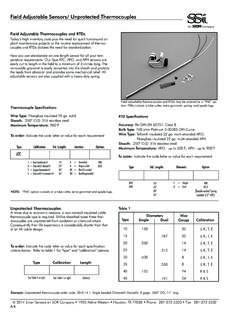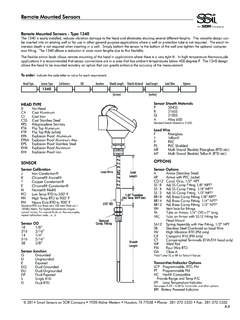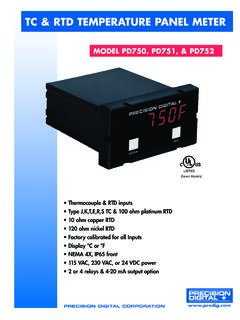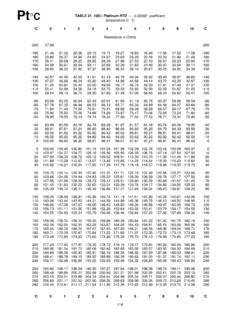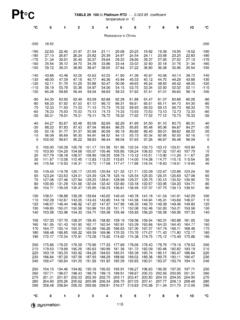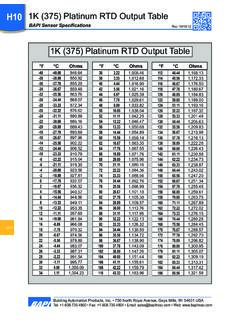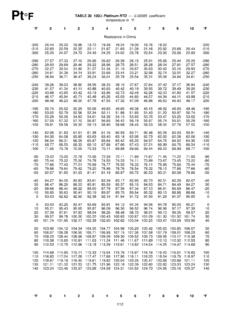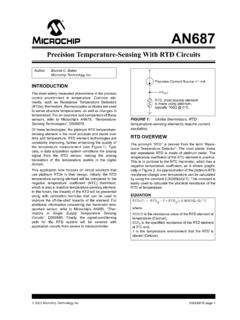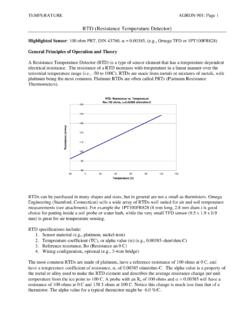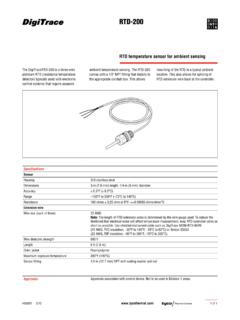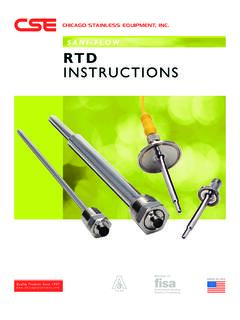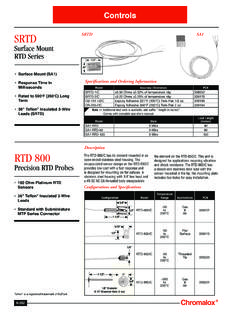Transcription of Specifying RTDs - Smart Sensors
1 2003 Smart Sensors , resistance temperature detector (RTD) operates on the prin-ciple that electrical resistance of metal changes as its tempera-ture changes. The resistance of the sensing element increases asthe temperature rises. There are two basic RTD designs wirewound and thin film. Wire wound design is a platinum sensingwire wound into a coil and housed in a ceramic mandrel toprotect the coil. The thin film design consists of platinumdeposited on a ceramic substrate and trimmed to achieve thedesired alpha the construction is then covered with glass andepoxy to protect platinum film. Thin films are manufacturedmuch in the same way as computer chipsThe metal that is employed in a RTD must change resistancewith respect to temperature and provide stability and a highoutput. The three metals that best exhibit these characteristicsare:PlatinumThe stability and linearity of this metals resistive output over abroad range makes it the best metal for process type RTD can withstand oxidation and is effective over a rangeof 200 to + 850 degrees C.
2 The four basic ohm values of100, 200, 500 and 1000 give the user different degrees ofsensitivity within the sensor. The higher the ohm value thegreater the sensitivity and resolution. See chart on page 8 forthe resistance change per degree Celsius for the temperaturecoefficient of resistance (TCR) for the RTD you are greatest strength of this metal is its low cost. Copperperforms poorly in oxidizing atmospheres and has a low outputand thus an inability to perform in narrow measuring metal is a good compromise between copper and has a higher output and is slightly less expensive than plati-num. It is extremely nonlinear above 300 degrees are known for their excellent accuracy and linearity over awide temperature range. Some rtds have accuracies as high ohms ( C) at 0 C. rtds are also extremely stabledevices. Common industrial rtds drift less than processes increasingly require precise processcontrol.
3 For this reason the number of rtds installed annuallycontinues to grow as a percentage of total temperature an RTD is a passive resistive device, you must pass acurrent through the device to produce a measurable current causes the RTD to internally heat, which appears asan error. You can minimize self-heating by using the smallestpossible excitation current. The typical RTD receiving device uses1mA to stimulate the are available in two-, three-, and four-wire number of lead wires directly affects such factors as accu-racy, stability, installation budget and distance between sensorand WireWhen accuracy is not critical, atwo-wire RTD is the least expen-sive; offering. Using lead wires toplace any distance between a two-wire RTD and a receiving devicewill further compromise itsaccuracy. The potential for pooraccuracy from a two-wire RTDstems from its inability to compensate for lead length, resistancethat changes the ohm value of the original signal.
4 A two-wireRTD should be used only in applications where the receivingdevice connects directly to the Wire RTDT hree-wire rtds compensate forresistance resulting from lengthdifferences by adding a third leadto the RTD. To accomplish thisrequires that the wires matchexactly. Any difference in resistancebetween the lead wires will causean imbalance, which will compro-mise the accuracy of the RTD. Lead length variance, workhardening or corrosion, and manufacturing irregularities areerrors to avoid. Quality manufacturing is critical to insurebalance of all three Wire RTDE rrors caused by resistanceimbalance between leads arecancelled out in a four-wire RTDcircuit. Four-wire rtds are usedwhere superior accuracy is criticalor if the sensor is installed far fromthe receiving device. In a four-wireRTD one pair of wires carries thecurrent through the RTD the other pair senses the voltage acrossthe RTD.
5 2- and three-wire rtds require heavier lead wirebecause thicker wire, by creating less resistance to the measuredSpecifying RTDsCeramic mandrel with internalbores to house coilsPlatinum sensing wirewound into a coil to fitinto the mandrel boresand the wire endsconnected to theplatinum lead orplatinumalloy wiresGlass coveringto protect foilconductorsCeramicsubstrateGlass or epoxycovering to protectlead wires atattachment pointsPlatinum film withconductors etchedor cut into itLead wire:Platinumcoated nickelor platinumalloyWire Wound Element DesignFilm Style Element Design8 2003 Smart Sensors , , reduces measurement distortion. Therefore lighter gaugewire, less expensive, may be used in four-wire RTD are limited to temperatures of 1200 F and because of theconstruction of the sensing element, rtds do not do well inhigh-vibration and severe mechanical shock selecting a temperature sensor for an application youshould consult your temperature sensor manufacturer : The industry has standardized on two types ofaccuracy for platinum 100 ohm RTD elements.
6 They are Class B,the standard in the process industry and the higher accuracyClass A. The table below shows typical element accuracies perDIN 43760-1980 and ASTM Time: Measured as the time necessary for a sensorto report a step change in temperature in water movingtransverse to the sensor sheath at 3 DiameterResponse Time1/8 2 Seconds3/16 3 Seconds1/4 5 SecondsRTD CharacteristicsStability: Defined as the ability of a sensor to maintain itsstated accuracy over an extended period of time, usually oneyear, at its rated temperature. rtds when used properly canmaintain a stability of .25 Repeatability: Defined as the ability to repeat the sameoutput value at a given temperature point in a spanned tem-perature range. rtds typically are repeatable to .14 C , whichever is Coefficient of Resistance (TCR)The temperature coefficient of a sensor is determined by thepurity of the winding wire used in the manufacture of the sensorelement.
7 It is defined as the resistance change per ohm perdegree C. Our standard rtds use the following TCRs: platinum =Curve A=.00392 ohms/ohm/ CCurve B=.003850 ohms/ohm/ CNickel=.006720 ohms/ohm/ CCopper=.004274 ohms/ohm/ CSensor Resistance Change per Degree at 0 C (32 F)Sensor Resistance C F100 ohm ohms200 ohm ohms400 ohm ohms500 ohm ohms1000 ohm ohms120 ohm ohms10 ohm ohms100 ohm ohmsRtTemperatureTolerance( C) C F C F AccuracyNickel (120 ohm)RtTemperatureTolerance( C) C F C F High AccuracyNickel (120 ohm)RtTemperatureTolerance( C) C F C F Accuracy - Copper( ohms @ 0 C / 10 ohms @ 25 C)RtTemperatureTolerance( C) C F C F High Accuracy - Copper( ohms @ 0 C / 10 ohms @ 25 C)Class BClass ATemperatureStandardHigh C F C F C (100 ohm)







